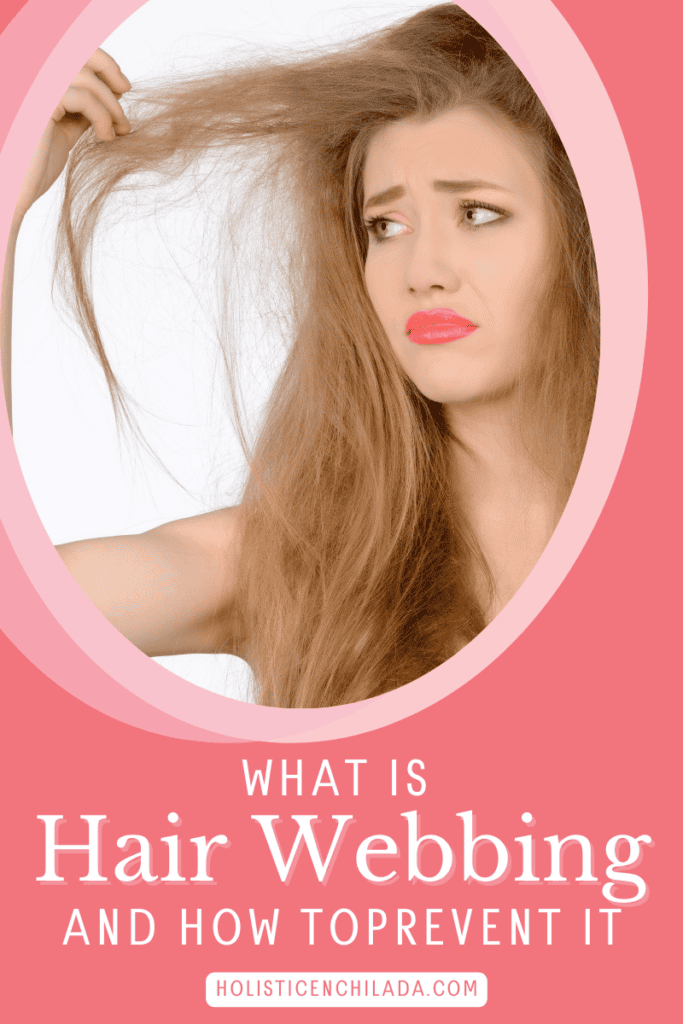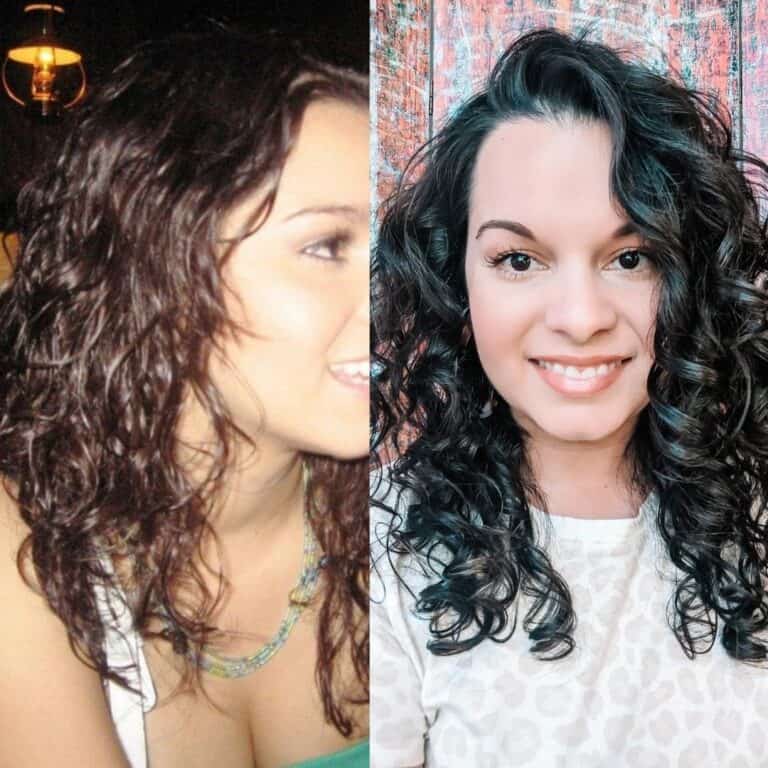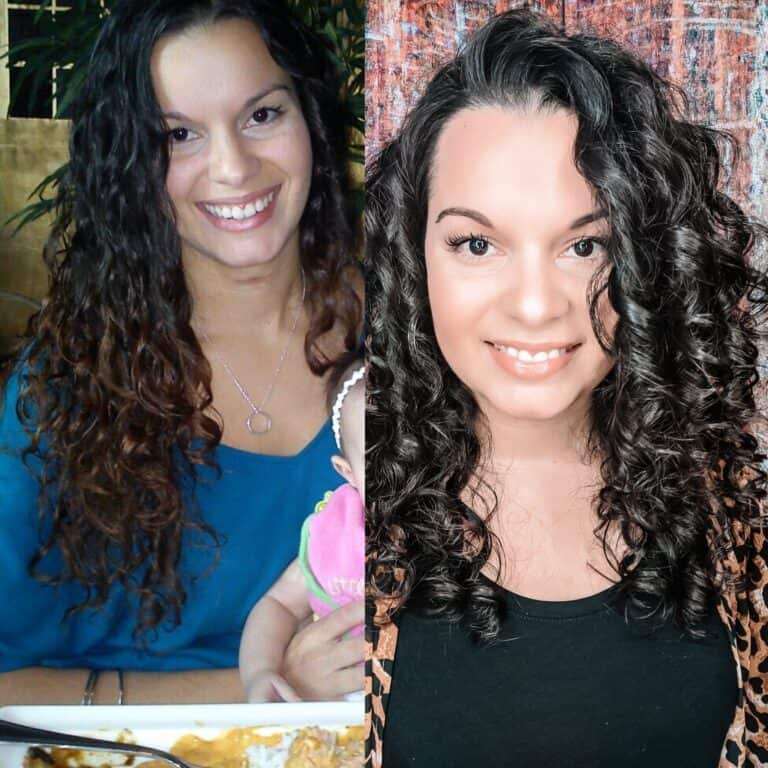What Is Hair Webbing and How to Prevent It
This post may contain affiliate links, and I will earn a commission if you purchase through these links. Please read the disclosure policy for more details.
You’ve probably dealt with various hair problems along your curly hair journey, like split ends and breakage. But have you ever noticed hair webbing in your mane?
Hair webbing is a common problem that leaves your strands tangled together in a web-like mass. It’s commonly experienced by people with a curly hair type, especially if their hair is fine.
It’s essential to deal with the problem as soon as you recognize it, because ignoring the early signs can lead to damage, breakage, or matting.
In this guide, we’ll explain what causes hair webbing and how to tell the difference between hair webs and other similar problems. We’ll also guide you through some simple steps to deal with hair webbing so you can restore your curls to their beautiful best.
What Is Hair Webbing?
Hair webbing is a problem where your hairs start to stick and weave together, forming a mass of tangles that looks a bit like a spider web. It often occurs near the roots, but you might also find webs forming further down the shaft.
Webbing is often caused by problems with moisture levels in the hair strands. It tends to affect fine hair more often than thick hair because fine strands are more susceptible to dryness.
Hair webbing is a common problem for people with natural hair and can become a recurring problem for some people.

Why Is Dealing With Hair Webbing Important?
Although early signs of hair webbing aren’t an emergency, they show that your hair needs attention to avoid further damage, especially on fine hair.
If you don’t address the problem quickly, the tangles will continue to grow and get worse. This will lead to breakage and matting, and a drastic cut could eventually be the only way to deal with the problem.
What Does Hair Webbing Look Like?
The best way to check for hair webbing is to gently pull apart a section of dry hair. If you have this problem, you’ll be able to see the strands sticking together in a web-like tangle, like in the photo below.
It’s a good idea to check a few sections to ensure you’re dealing with hair webbing and not a different problem.

Other Hair Problems That Look Like Hair Webbing
Understanding the issue you’re experiencing is the first step to dealing with it. But it’s easy to mistake hair webbing for other problems, especially if you’re not entirely sure what webbing looks like.
Some of the other issues that look similar to hair webbing include:
Wet Frizz
Extreme frizz after washing your hair can look similar to hair webbing. It’s easily solved by conditioning your hair regularly and patting your hair dry with a cotton t-shirt or microfiber towel to reduce friction.
Hair Tangling
This is a general term that can cover everything from loose tangles to serious knots. Hair webs are a form of tangling, but they have a more distinctive web-like texture.
Hair Matting
Ignoring tangles and webbing can lead to the problem developing into matting. This is a more serious problem where larger sections of hair tangle into a thick mass. Detangling matted hair takes time and patience, and the worst cases may have to be cut out.
Hair Knotting
Knotting occurs when individual hair strands wrap around themselves or other strands to form knots. It often involves shed hair that hasn’t fallen yet, whereas hair webbing tends to be caused by hair strands that haven’t been shed.
You’ll also find that knotting tends to form closer to the ends of your strands, while webbing usually forms close to the roots and grows from there.

What Causes Hair Webbing?
Various factors cause hair webbing, and they’re often interconnected. Once you’ve identified the reasons why your curls are sticking together, it’s easier to work out how to solve the problem.
Here are the some of the main causes:
Lack of Moisture
The main cause of hair webbing is a lack of moisture. The cuticle on well-moisturized hair will lay flat along the shaft, which makes the hair smooth.
When hair is under-moisturized, the scales on the cuticle layer become raised, which makes the strands snag and stick together. This leads to tangling and breakage, and eventually, you end up with webbing.
There are many causes of dry hair, but some of the main ones are poor hair care, product buildup, and damage from heat, chemicals, or environmental factors.
Poor Hair Care Routine
Problems with your wash day routine can easily lead to your curls being dehydrated. This might be through excessive washing, using shampoos containing sulfates, or not conditioning your locks regularly.
Some styling products also contain alcohols that can make the dryness worse.
Product Buildup
Hair care products like shampoos, conditioners, and styling products help keep your tresses looking fabulous, but they can build up on your scalp and strands over time.
This accumulation of residue can leave your hair looking dull and stop moisture from penetrating the hair shaft. It can also cause your strands to stick together, resulting in hair webbing.
Heat, Chemical, and Environmental damage
Frequent exposure to direct heat from hot styling tools and chemical treatments like colors or perms can dry out your strands.
Everyday environmental damage from extreme cold weather, sunlight, or the chlorine in swimming pool water can also rob your hair of moisture.
Hygral Fatigue
Conditioning your hair is vital for healthy hair, but it’s possible to over-moisturize your tresses. This can happen if you leave deep conditioning treatments on too long or leave your hair soaking wet after washes.
Using conditioners too long or too frequently can cause an imbalance of moisture and protein in your strands. This leads to a condition called hygral fatigue, which leaves your hair feeling gummy and easily overstretched.
Excessive Use of Protective Hairstyles
Protective hairstyles like braids, buns, and twists are an important part of caring for natural hair. They help safeguard your tresses from the damage that wind, rain, and humidity can cause.
However, it’s essential not to wear protective hairstyles too long, as this can lead to dry hair and webbing.
Other causes of hair webbing include missing essential nutrients from your diet and underlying health problems like hormonal imbalances, as well as touching your hair or using your brush too often.

How To Prevent Hair Webbing
Now that you understand what causes hair webbing, these simple steps will help stop hair webbing developing.
Effective Hair Cleansing
Cleansing your hair removes dirt and oils from your strands and allows them to absorb moisture more easily.
Many shampoos contain sulfates, such as Sodium lauryl sulfate, Sodium laureth sulfate, or Ammonium laureth sulfate. These foaming agents help the product work more effectively, but they can also leave your hair dry and your scalp feeling tight and irritated.
Choosing sulfate-free shampoos is better for healthy hair and helps prevent hair webbing. You could also try co-washing your hair with a dedicated co-wash or conditioner, which can be very beneficial to naturally curly hair, but remember it is not ideal to only cowash.
Gentle Detangling
Regular detangling is one of the best ways to avoid hair webbing, and it’s always essential to lubricate the strands with an oil, leave in conditioner, or detangling product.
You can either apply your chosen detangler to detangle dry locks before you shampoo or apply it to wet locks after shampooing for wet detangling.
Let the product sit on your strands for a few minutes and detangle gently with a wide-toothed comb, specialist detangling brush, or your fingers.
Limit Heat Styling
Using blow dryers, curling wands, and flat irons to style your hair can dry your strands, leaving them brittle and likely to cause hair webbing.
It’s better to avoid heat styling tools as much as possible. If you must use them, use the lower heat settings and always apply a heat protectant first.
Regular Deep Cleaning
Removing product buildup is an essential part of avoiding hair webbing. So, using a clarifying shampoo to give your hair a regular deep clean should be a regular part of your hair care routine.
This will remove any buildup of products, sweat, and dead skin cells from your hair and scalp, making it easier for your hair to absorb hydration and nourishment.
Experts recommend using a clarifying shampoo to wash your hair once or twice a month, and you could use it up to once a week if your hair will tolerate it. Always follow up with a deep conditioner, as clarifying shampoos can strip the oils from your strands.
Moisturizing Products
Dehydrated strands can easily tangle into webbing, so restoring moisture to dry and damaged hair is essential. You can use a combination of rinse out conditioners, deep conditioners and leave in conditioners to pamper your locks.
Regular deep conditioning treatments will smooth and soften your hair, making it less likely to tangle. Using a deep conditioning treatment at least once monthly is ideal, especially after washing your hair with a clarifying shampoo.
Look out for treatments containing penetrating oils like argan or coconut oil and shea butter to deliver moisture deep within the hair shaft. Following up with a sealing oil like jojoba or black castor oil will help lock the moisture in, which is especially important on high porosity hair that struggles to retain hydration.
Hydration From Inside
It’s important to remember that healthy hair needs hydration from within as well as external hydration. Not drinking enough water can leave your locks brittle and may even affect your follicles, which can lead to hair loss.
So, ensure you’re well hydrated to safeguard your healthy hair growth.
Wearing a Protective Hairstyle
Leaving naturally curly hair loose can easily lead to hair webbing, so a protective style is a great way to avoid the tangles that cause webbing.
A protective hairstyle like a bun or braids helps lock in moisture, prevent tangles, and cut down the time you have to spend caring for your curls.
However, leaving your curls in a protective hairstyle for too long can also lead to webbing, as loose hairs, dirt, and sebum get tangled with new growth at the roots.
So, you can wear a protective hairstyle for around 90% of the time, but it’s a good idea to give your hair a rest every six to eight weeks.
Regular Hair Trims
Regular trims are essential if you want to avoid hair webbing. Long hair is more prone to tangles and often develops split ends, which can lead to hair webbing. Trimming off the frayed ends will also help keep your hair looking healthier.
Experts recommend visiting the salon for a trim at least once every three months, or more often if your tresses are regularly exposed to hot styling tools or chemical processing, such as perms and colors.
How To Get Rid Of Hair Webbing
It’s better to avoid hair webbing as much as possible. However, if you do find that you’re suffering from this problem, protein treatments can help get rid of it.
They fill in any gaps along the shaft, which will help strengthen your strands. Strong hair is less likely to break or tangle and form hair webbing.
Protein treatments are also helpful if your hair webbing is caused by an imbalance between moisture and protein. This imbalance can lead to hygral fatigue and adding protein can help correct the problem.
However, too much protein can leave hair brittle and easy to break, so make sure you balance protein treatments with enough moisture.
Along with protein treatments, you should continue to follow the advice above on avoiding hair webbing.
FAQs
If you’re still looking for more information about hair webbing, these frequently asked questions will help.
Is There a Specific Hair Type Prone To Webbing or Tangling?
All hair types can experience hair webbing. Fine hair is especially susceptible to it, as the strands are more likely to suffer dryness and can easily get tangled together.
What Is Wet Frizz?
Wet frizz occurs when your hair feels dry and tangled when it’s still wet from being washed. You might notice it when you’ve squeezed out the excess water after rinsing your hair or when you’re combing through styling products.
You can handle wet frizz by using a moisturizing rinse out conditioner and gently blotting your curls dry with a cotton T-shirt instead of rubbing it dry. Additionally, using a frizz-control product or leave-in conditioner can also help you avoid wet frizz.
What’s the Difference Between Hair Webbing and Knotting?
Single-strand knots or fairy hair knots are tiny knots on individual strands of hair. They are especially common on curly and coily hair types because the curl pattern allows the strands to loop and knot onto themselves.
The Bottom Line
Hair webbing is a challenge experienced by many curly girls and is usually caused by excessive dryness.
Factors like poor care, product buildup, and damage from heat styling or chemicals can all cause curls to snag and lock together in web-like tangles, leaving your hair limp and lifeless.
Without proper care, hair webbing can lead to damage and matting. But luckily, there are a few easy steps you can take to prevent webbing, even in fine hair.
Proper washing and moisturizing, gentle detangling, and regular deep cleansing will all keep webs away. Protective hairstyles are another effective measure, but remember to give your hair regular breaks and keep up to date with trims.
These simple tips will keep your locks free from webbing and give your tresses back their bounce.








